Interactive STEM Model: Atomic Structure for Primary Science
VerifiedAdded on 2022/09/13
|17
|1635
|15
Project
AI Summary
This assignment presents an interactive STEM model designed for primary science education, focusing on the fundamental molecular structure of atoms. It outlines a hands-on learning activity where students, organized into groups, construct Bohr's model using colored beads and straw baskets to represent subatomic particles (protons, neutrons, and electrons) within orbital diagrams. The activity encourages group discussions and debates, fostering critical thinking about the evolution of atomic theory and the behavior of subatomic particles. The model aligns with the Victorian Primary Science Curriculum and integrates the 5E learning model (Engage, Explore, Explain, Elaborate, Evaluate). The assignment includes specific advantages, limitations, assessment strategies, and alignment with STEM education principles, referencing relevant resources and standards like AITSL. The model aims to enhance students' understanding of atomic structures, electrical charges, and the roles of subatomic particles, while also addressing potential misconceptions and providing guidance for differentiated instruction.
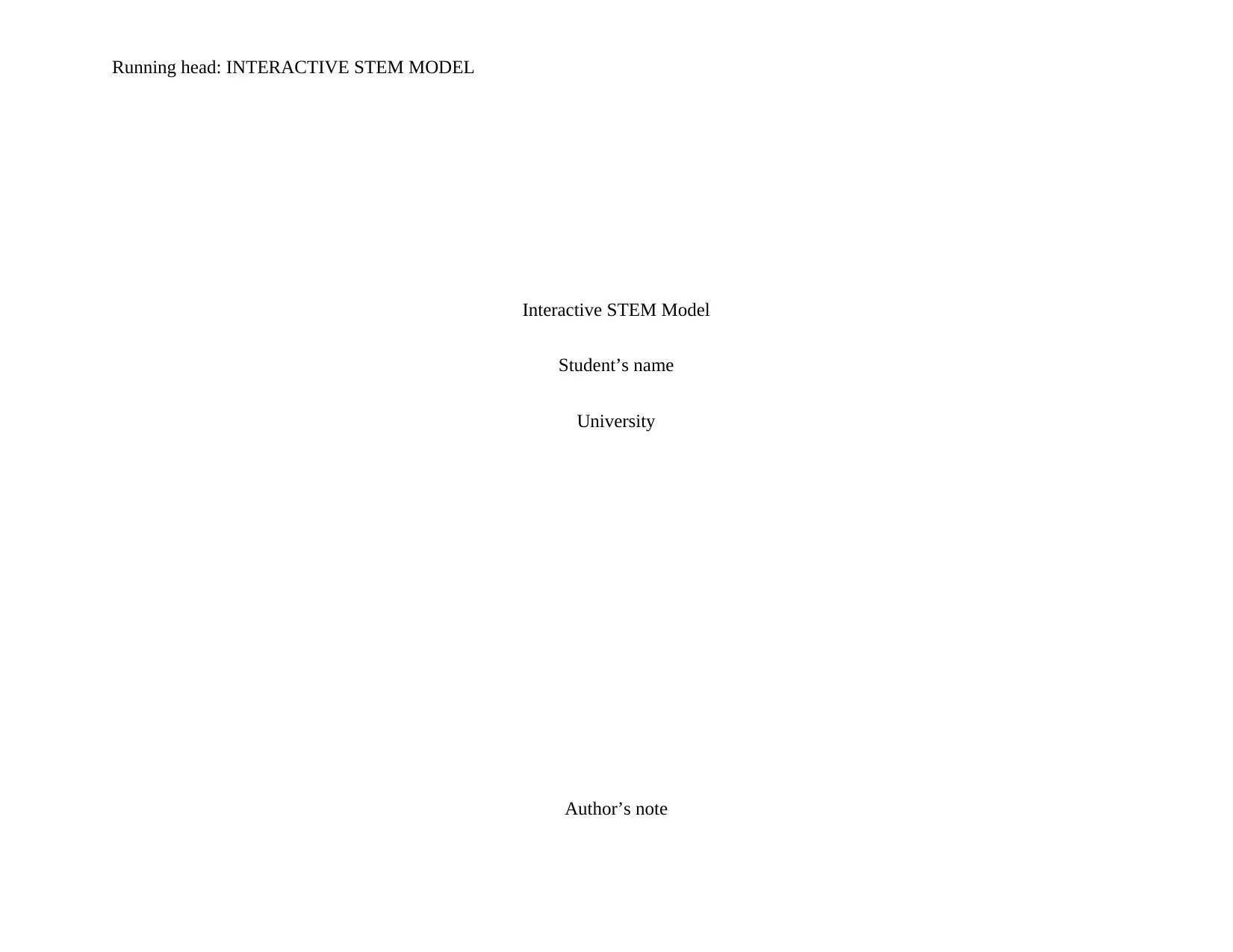
Running head: INTERACTIVE STEM MODEL
Interactive STEM Model
Student’s name
University
Author’s note
Interactive STEM Model
Student’s name
University
Author’s note
Paraphrase This Document
Need a fresh take? Get an instant paraphrase of this document with our AI Paraphraser

1
INTERACTIVE STEM MODEL
Key scientific concept associated with your model. Link to the Victorian Primary Science Curriculum /
Early Years Learning Framework (EYLF) and a Big
Idea in Science.
The key scientific concepts embedded in the learning
program are the understanding of the fundamental
Victorian Curriculum Descriptor: VCSSU122
Levels 9 & 10: All matter is made of atoms which are
composed of protons, neutrons and electrons; natural
INTERACTIVE STEM MODEL
Key scientific concept associated with your model. Link to the Victorian Primary Science Curriculum /
Early Years Learning Framework (EYLF) and a Big
Idea in Science.
The key scientific concepts embedded in the learning
program are the understanding of the fundamental
Victorian Curriculum Descriptor: VCSSU122
Levels 9 & 10: All matter is made of atoms which are
composed of protons, neutrons and electrons; natural

2
INTERACTIVE STEM MODEL
model of molecular structure of atoms. radioactivity arises from the decay of nuclei in atoms
(Victorian Curriculum and Assessment Authority
2020).
Elaborations:
describing and modeling the structure of atoms in
terms of the nucleus, protons, neutrons and
electrons
comparing the mass and charge of protons, neutrons
and electrons
Big Idea of Science Descriptor: All matter in the
Universe is made of very small particles.
Interactive Models
INTERACTIVE STEM MODEL
model of molecular structure of atoms. radioactivity arises from the decay of nuclei in atoms
(Victorian Curriculum and Assessment Authority
2020).
Elaborations:
describing and modeling the structure of atoms in
terms of the nucleus, protons, neutrons and
electrons
comparing the mass and charge of protons, neutrons
and electrons
Big Idea of Science Descriptor: All matter in the
Universe is made of very small particles.
Interactive Models
⊘ This is a preview!⊘
Do you want full access?
Subscribe today to unlock all pages.

Trusted by 1+ million students worldwide

3
INTERACTIVE STEM MODEL
Model 1: Plum Pudding Model
Model 2: Orbital Model (Bohr’s model)
INTERACTIVE STEM MODEL
Model 1: Plum Pudding Model
Model 2: Orbital Model (Bohr’s model)
Paraphrase This Document
Need a fresh take? Get an instant paraphrase of this document with our AI Paraphraser
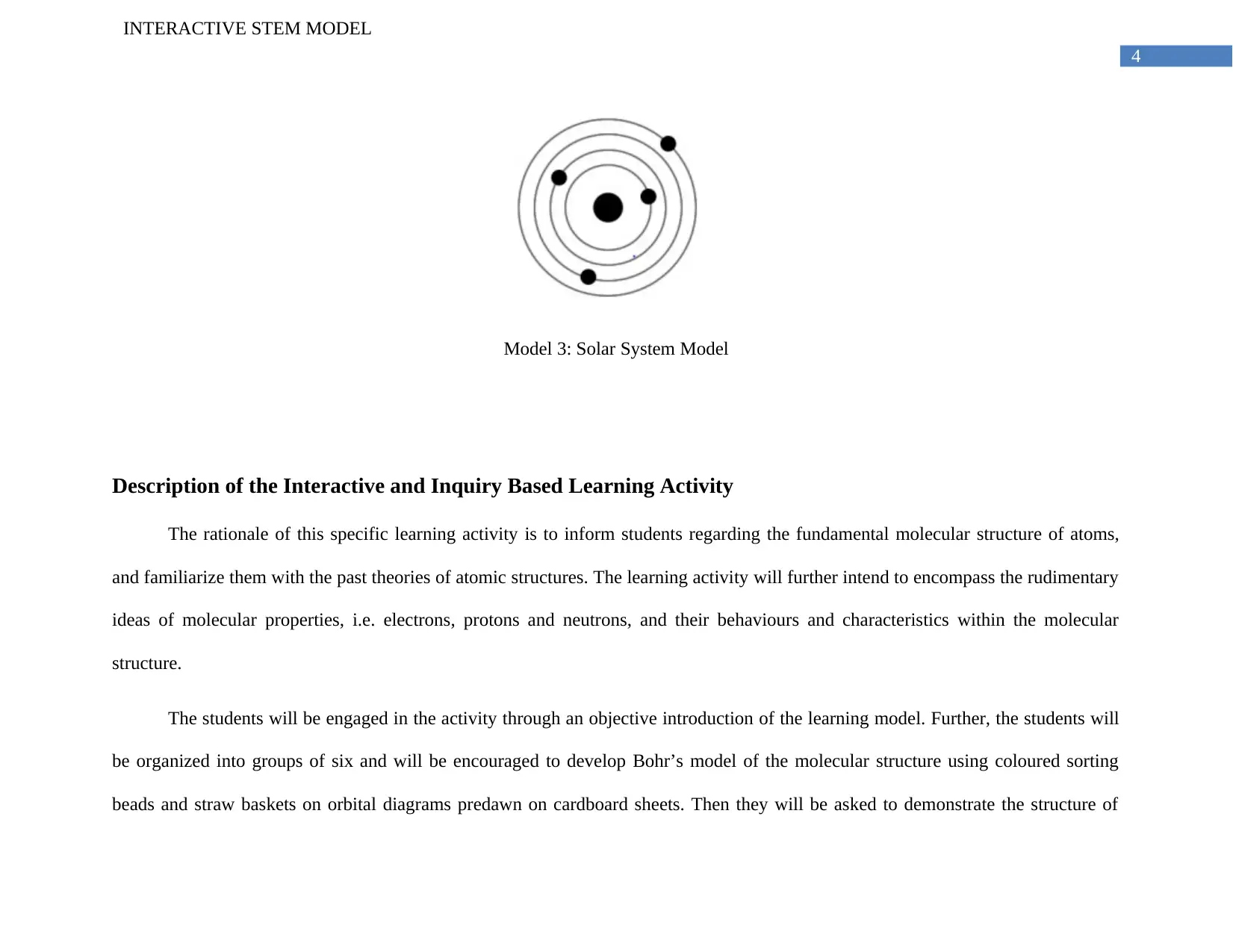
4
INTERACTIVE STEM MODEL
Model 3: Solar System Model
Description of the Interactive and Inquiry Based Learning Activity
The rationale of this specific learning activity is to inform students regarding the fundamental molecular structure of atoms,
and familiarize them with the past theories of atomic structures. The learning activity will further intend to encompass the rudimentary
ideas of molecular properties, i.e. electrons, protons and neutrons, and their behaviours and characteristics within the molecular
structure.
The students will be engaged in the activity through an objective introduction of the learning model. Further, the students will
be organized into groups of six and will be encouraged to develop Bohr’s model of the molecular structure using coloured sorting
beads and straw baskets on orbital diagrams predawn on cardboard sheets. Then they will be asked to demonstrate the structure of
INTERACTIVE STEM MODEL
Model 3: Solar System Model
Description of the Interactive and Inquiry Based Learning Activity
The rationale of this specific learning activity is to inform students regarding the fundamental molecular structure of atoms,
and familiarize them with the past theories of atomic structures. The learning activity will further intend to encompass the rudimentary
ideas of molecular properties, i.e. electrons, protons and neutrons, and their behaviours and characteristics within the molecular
structure.
The students will be engaged in the activity through an objective introduction of the learning model. Further, the students will
be organized into groups of six and will be encouraged to develop Bohr’s model of the molecular structure using coloured sorting
beads and straw baskets on orbital diagrams predawn on cardboard sheets. Then they will be asked to demonstrate the structure of
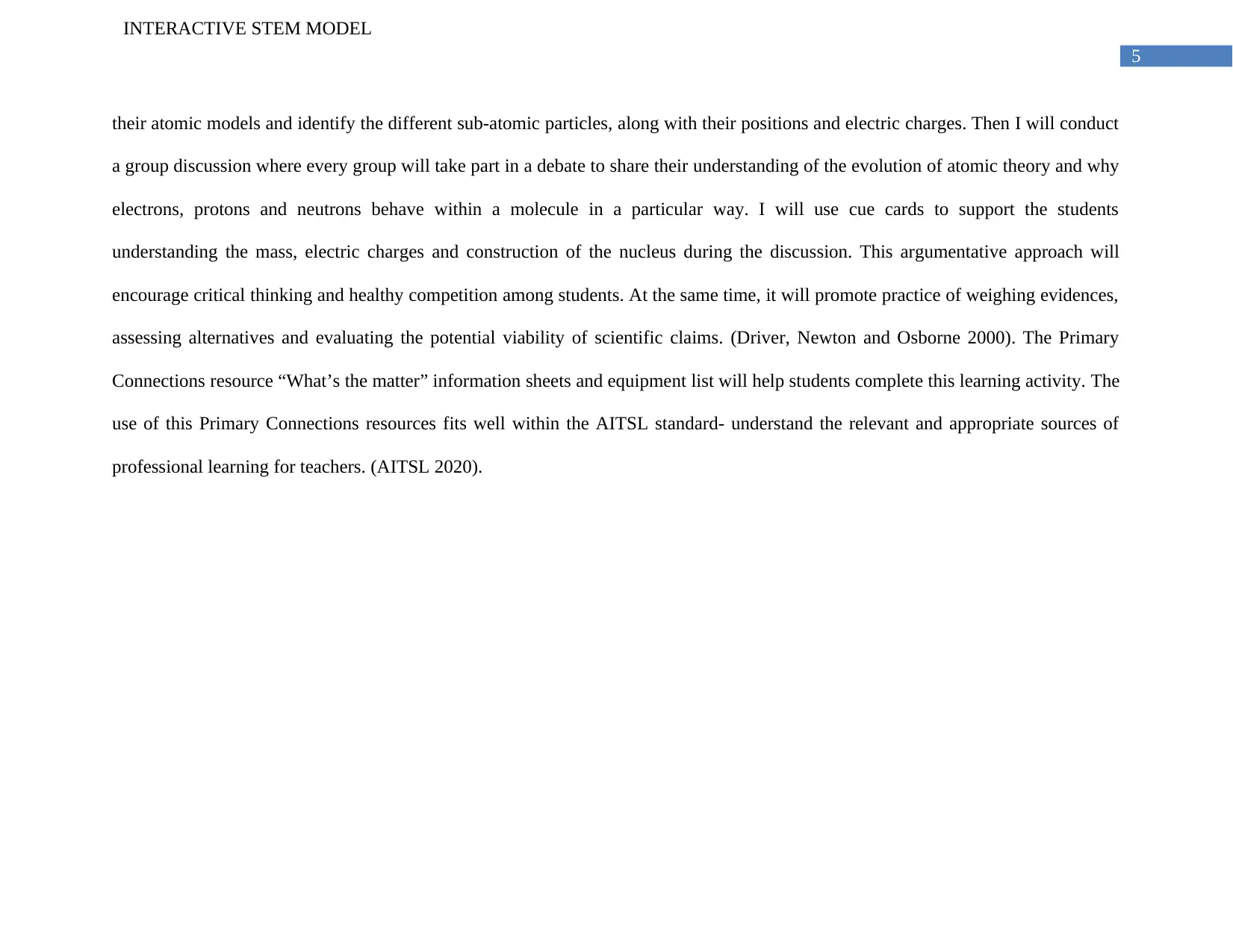
5
INTERACTIVE STEM MODEL
their atomic models and identify the different sub-atomic particles, along with their positions and electric charges. Then I will conduct
a group discussion where every group will take part in a debate to share their understanding of the evolution of atomic theory and why
electrons, protons and neutrons behave within a molecule in a particular way. I will use cue cards to support the students
understanding the mass, electric charges and construction of the nucleus during the discussion. This argumentative approach will
encourage critical thinking and healthy competition among students. At the same time, it will promote practice of weighing evidences,
assessing alternatives and evaluating the potential viability of scientific claims. (Driver, Newton and Osborne 2000). The Primary
Connections resource “What’s the matter” information sheets and equipment list will help students complete this learning activity. The
use of this Primary Connections resources fits well within the AITSL standard- understand the relevant and appropriate sources of
professional learning for teachers. (AITSL 2020).
INTERACTIVE STEM MODEL
their atomic models and identify the different sub-atomic particles, along with their positions and electric charges. Then I will conduct
a group discussion where every group will take part in a debate to share their understanding of the evolution of atomic theory and why
electrons, protons and neutrons behave within a molecule in a particular way. I will use cue cards to support the students
understanding the mass, electric charges and construction of the nucleus during the discussion. This argumentative approach will
encourage critical thinking and healthy competition among students. At the same time, it will promote practice of weighing evidences,
assessing alternatives and evaluating the potential viability of scientific claims. (Driver, Newton and Osborne 2000). The Primary
Connections resource “What’s the matter” information sheets and equipment list will help students complete this learning activity. The
use of this Primary Connections resources fits well within the AITSL standard- understand the relevant and appropriate sources of
professional learning for teachers. (AITSL 2020).
⊘ This is a preview!⊘
Do you want full access?
Subscribe today to unlock all pages.

Trusted by 1+ million students worldwide

6
INTERACTIVE STEM MODEL
Specific Advantages of Using the Model Specific examples of key questions
1. Students can learn the specific structure of atoms and
molecules.
2. Students can learn about the specific electrical charges,
masses and locations of electrons, protons and neutrons,
e.g. electrons carry negative charge and are responsible
for chemical reactions, neutrons carry neutral charge
and constitute the mass of the atom etc.
3. They will also be able to identify the central role of
neutrons in identifying the identity of particular
elements.
This links to VCSSU122--All matter is made of atoms
which are composed of protons, neutrons and electrons; natural
radioactivity arises from the decay of nuclei in atoms
1. What is the structure of an atom?
2. What are the sub-atomic particles?
3. Can these sub-atomic parts be seen easily?
4. How has the atoms been demonstrated by early
scientists?
5. What constitutes the nucleus of an atom?
6. Which particle carries the positive/negative charge?
Developing specific questions to evaluate the depth of their
understanding helps teachers plan for further lessons. This
links to AITSL standard 2.1 on knowing the content and
how to teach it. (AITSL 2020).
INTERACTIVE STEM MODEL
Specific Advantages of Using the Model Specific examples of key questions
1. Students can learn the specific structure of atoms and
molecules.
2. Students can learn about the specific electrical charges,
masses and locations of electrons, protons and neutrons,
e.g. electrons carry negative charge and are responsible
for chemical reactions, neutrons carry neutral charge
and constitute the mass of the atom etc.
3. They will also be able to identify the central role of
neutrons in identifying the identity of particular
elements.
This links to VCSSU122--All matter is made of atoms
which are composed of protons, neutrons and electrons; natural
radioactivity arises from the decay of nuclei in atoms
1. What is the structure of an atom?
2. What are the sub-atomic particles?
3. Can these sub-atomic parts be seen easily?
4. How has the atoms been demonstrated by early
scientists?
5. What constitutes the nucleus of an atom?
6. Which particle carries the positive/negative charge?
Developing specific questions to evaluate the depth of their
understanding helps teachers plan for further lessons. This
links to AITSL standard 2.1 on knowing the content and
how to teach it. (AITSL 2020).
Paraphrase This Document
Need a fresh take? Get an instant paraphrase of this document with our AI Paraphraser

7
INTERACTIVE STEM MODEL
(Victorian Curriculum and Assessment Authority 2020).
INTERACTIVE STEM MODEL
(Victorian Curriculum and Assessment Authority 2020).

8
INTERACTIVE STEM MODEL
Alignment with 5E Learning Model
Engage: Watch a video of the Atom Song
https://www.youtube.com/watch?v=oFLH_0B4ZLg
Explore: Groups discussing understanding of the arrangements
of molecular particles and their masses and electric charges
Explain: Groups explain behaviours of electron, proton and
neutrons along with why neutrons make the masses of atoms
Elaborate: going on an excursion to the STEM workshops at
Scienceworks’ to participate in the Beyond Perception: Seeing
the Unseen program, followed by a discussion session on how
the molecular structure is understood in the particle accelerators
facility.
Evaluate: ANCQ practice quiz for intermediate years compiled
questions for assessing students’ knowledge on atomic
Specific Limitation of the Model
Many students may fail to grasp the
difference between atoms and molecules
This model does not include the
representation of periodical table, which may
affect student’s understanding of atomic
structures of different elements.
Students may find it difficult how the electric
charges vary in same atoms.
INTERACTIVE STEM MODEL
Alignment with 5E Learning Model
Engage: Watch a video of the Atom Song
https://www.youtube.com/watch?v=oFLH_0B4ZLg
Explore: Groups discussing understanding of the arrangements
of molecular particles and their masses and electric charges
Explain: Groups explain behaviours of electron, proton and
neutrons along with why neutrons make the masses of atoms
Elaborate: going on an excursion to the STEM workshops at
Scienceworks’ to participate in the Beyond Perception: Seeing
the Unseen program, followed by a discussion session on how
the molecular structure is understood in the particle accelerators
facility.
Evaluate: ANCQ practice quiz for intermediate years compiled
questions for assessing students’ knowledge on atomic
Specific Limitation of the Model
Many students may fail to grasp the
difference between atoms and molecules
This model does not include the
representation of periodical table, which may
affect student’s understanding of atomic
structures of different elements.
Students may find it difficult how the electric
charges vary in same atoms.
⊘ This is a preview!⊘
Do you want full access?
Subscribe today to unlock all pages.

Trusted by 1+ million students worldwide
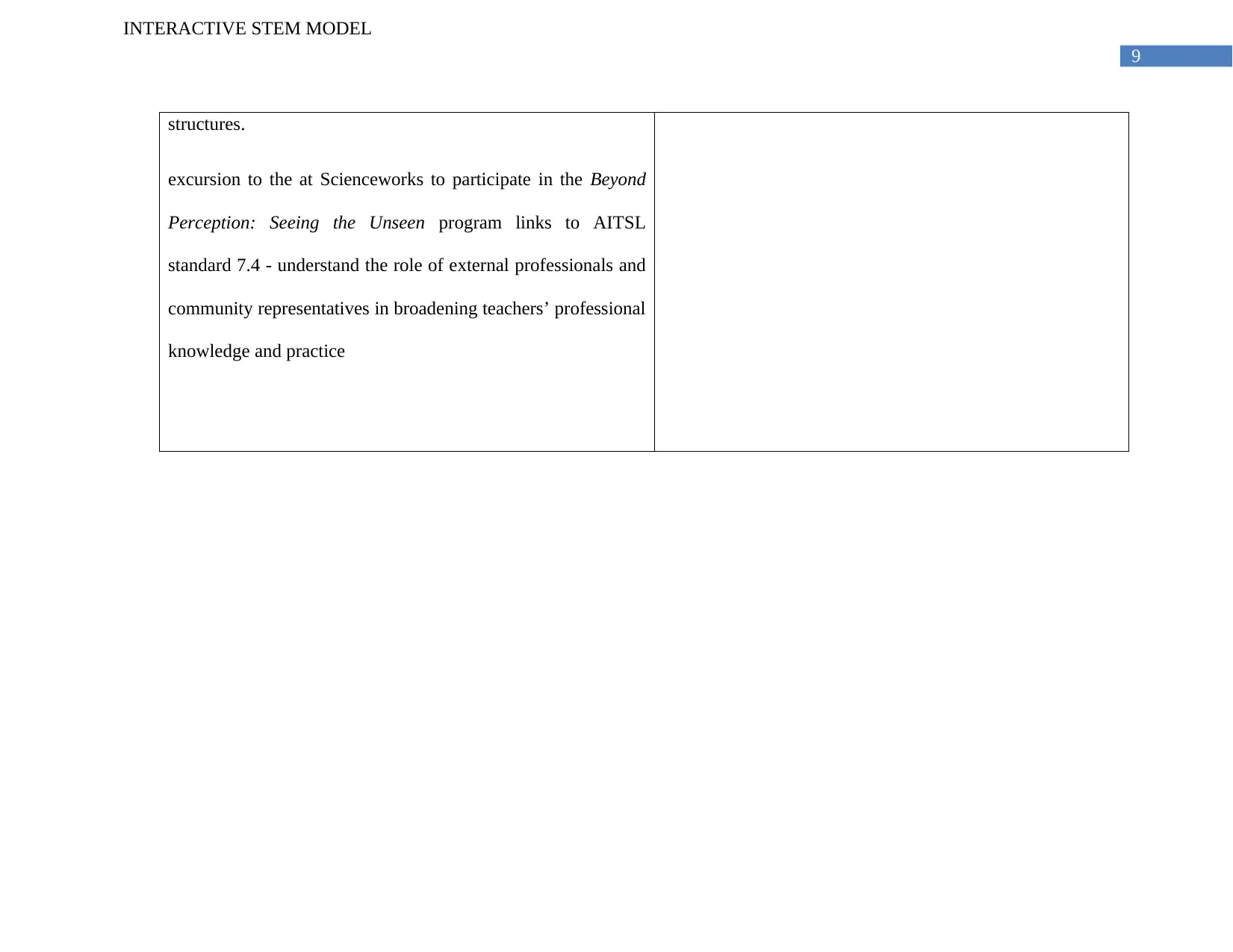
9
INTERACTIVE STEM MODEL
structures.
excursion to the at Scienceworks to participate in the Beyond
Perception: Seeing the Unseen program links to AITSL
standard 7.4 - understand the role of external professionals and
community representatives in broadening teachers’ professional
knowledge and practice
INTERACTIVE STEM MODEL
structures.
excursion to the at Scienceworks to participate in the Beyond
Perception: Seeing the Unseen program links to AITSL
standard 7.4 - understand the role of external professionals and
community representatives in broadening teachers’ professional
knowledge and practice
Paraphrase This Document
Need a fresh take? Get an instant paraphrase of this document with our AI Paraphraser

10
INTERACTIVE STEM MODEL
Feedback Assessment
Performing Below Level: Provide students with peer support
to develop the understanding the structure of atoms
Performing at Level: Encourage students to take up leading
role in group discussions, e.g. demonstrating the different
electric charges of the sub-atomic particles
Above Level: Encourage students to explore the periodical
tables to identify different elements with different atomic
structures.
Alignment with the principles of STEM
education
Science: The fundamental scientific structure of atoms and
its place in chemical science
Technology: Can be placed in demonstrating chemical
reactions to develop different compounds
Engineering: Can be linked with understanding the
development of electronic gadgets such as smartphones,
LED lights etc.
Mathematics: The idea of atomic mass as well as the
chemical bonding depending on free electrons (Victorian
Curriculum and Assessment Authority 2020).
INTERACTIVE STEM MODEL
Feedback Assessment
Performing Below Level: Provide students with peer support
to develop the understanding the structure of atoms
Performing at Level: Encourage students to take up leading
role in group discussions, e.g. demonstrating the different
electric charges of the sub-atomic particles
Above Level: Encourage students to explore the periodical
tables to identify different elements with different atomic
structures.
Alignment with the principles of STEM
education
Science: The fundamental scientific structure of atoms and
its place in chemical science
Technology: Can be placed in demonstrating chemical
reactions to develop different compounds
Engineering: Can be linked with understanding the
development of electronic gadgets such as smartphones,
LED lights etc.
Mathematics: The idea of atomic mass as well as the
chemical bonding depending on free electrons (Victorian
Curriculum and Assessment Authority 2020).
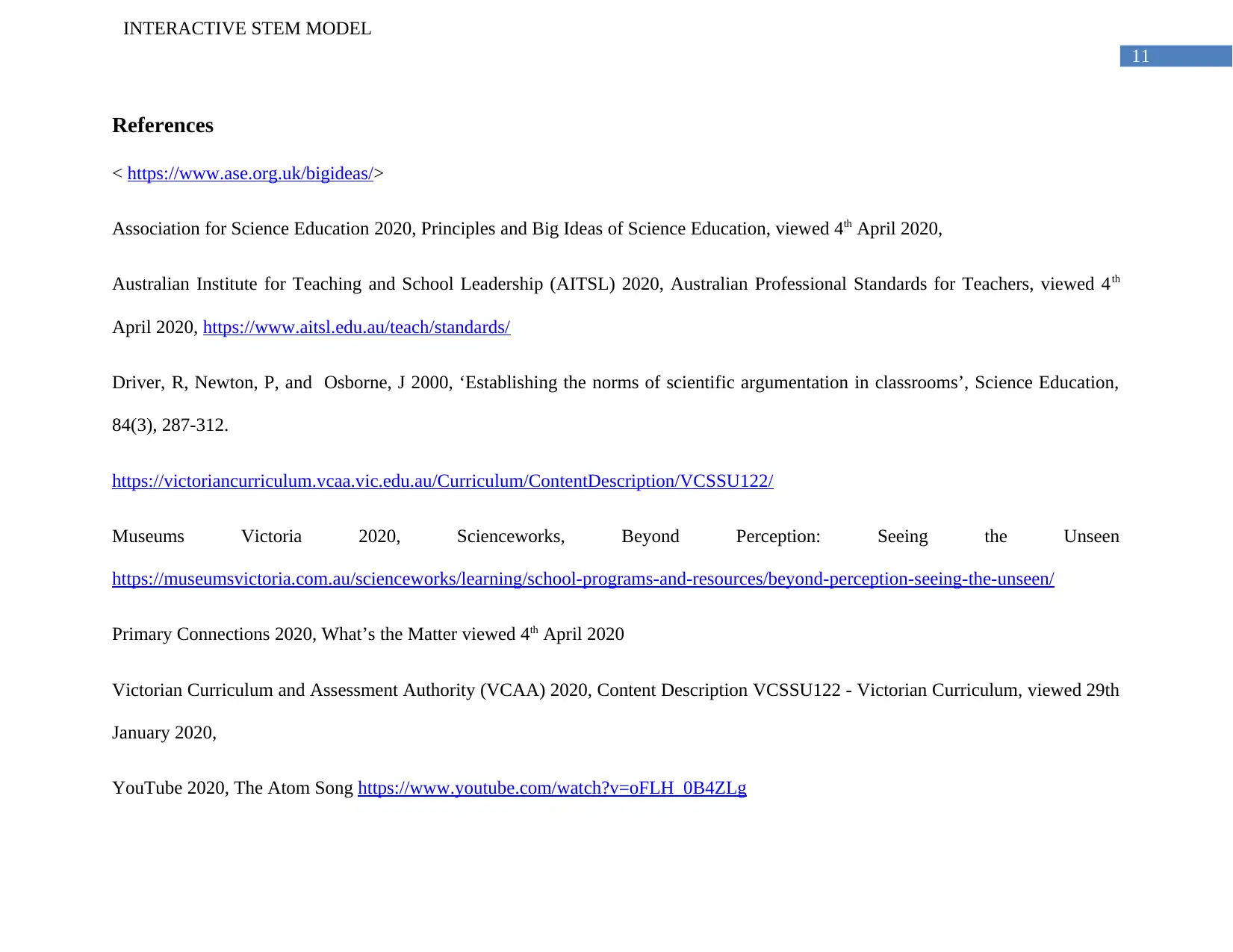
11
INTERACTIVE STEM MODEL
References
< https://www.ase.org.uk/bigideas/>
Association for Science Education 2020, Principles and Big Ideas of Science Education, viewed 4th April 2020,
Australian Institute for Teaching and School Leadership (AITSL) 2020, Australian Professional Standards for Teachers, viewed 4th
April 2020, https://www.aitsl.edu.au/teach/standards/
Driver, R, Newton, P, and Osborne, J 2000, ‘Establishing the norms of scientific argumentation in classrooms’, Science Education,
84(3), 287-312.
https://victoriancurriculum.vcaa.vic.edu.au/Curriculum/ContentDescription/VCSSU122/
Museums Victoria 2020, Scienceworks, Beyond Perception: Seeing the Unseen
https://museumsvictoria.com.au/scienceworks/learning/school-programs-and-resources/beyond-perception-seeing-the-unseen/
Primary Connections 2020, What’s the Matter viewed 4th April 2020
Victorian Curriculum and Assessment Authority (VCAA) 2020, Content Description VCSSU122 - Victorian Curriculum, viewed 29th
January 2020,
YouTube 2020, The Atom Song https://www.youtube.com/watch?v=oFLH_0B4ZLg
INTERACTIVE STEM MODEL
References
< https://www.ase.org.uk/bigideas/>
Association for Science Education 2020, Principles and Big Ideas of Science Education, viewed 4th April 2020,
Australian Institute for Teaching and School Leadership (AITSL) 2020, Australian Professional Standards for Teachers, viewed 4th
April 2020, https://www.aitsl.edu.au/teach/standards/
Driver, R, Newton, P, and Osborne, J 2000, ‘Establishing the norms of scientific argumentation in classrooms’, Science Education,
84(3), 287-312.
https://victoriancurriculum.vcaa.vic.edu.au/Curriculum/ContentDescription/VCSSU122/
Museums Victoria 2020, Scienceworks, Beyond Perception: Seeing the Unseen
https://museumsvictoria.com.au/scienceworks/learning/school-programs-and-resources/beyond-perception-seeing-the-unseen/
Primary Connections 2020, What’s the Matter viewed 4th April 2020
Victorian Curriculum and Assessment Authority (VCAA) 2020, Content Description VCSSU122 - Victorian Curriculum, viewed 29th
January 2020,
YouTube 2020, The Atom Song https://www.youtube.com/watch?v=oFLH_0B4ZLg
⊘ This is a preview!⊘
Do you want full access?
Subscribe today to unlock all pages.

Trusted by 1+ million students worldwide
1 out of 17
Your All-in-One AI-Powered Toolkit for Academic Success.
+13062052269
info@desklib.com
Available 24*7 on WhatsApp / Email
![[object Object]](/_next/static/media/star-bottom.7253800d.svg)
Unlock your academic potential
Copyright © 2020–2025 A2Z Services. All Rights Reserved. Developed and managed by ZUCOL.

